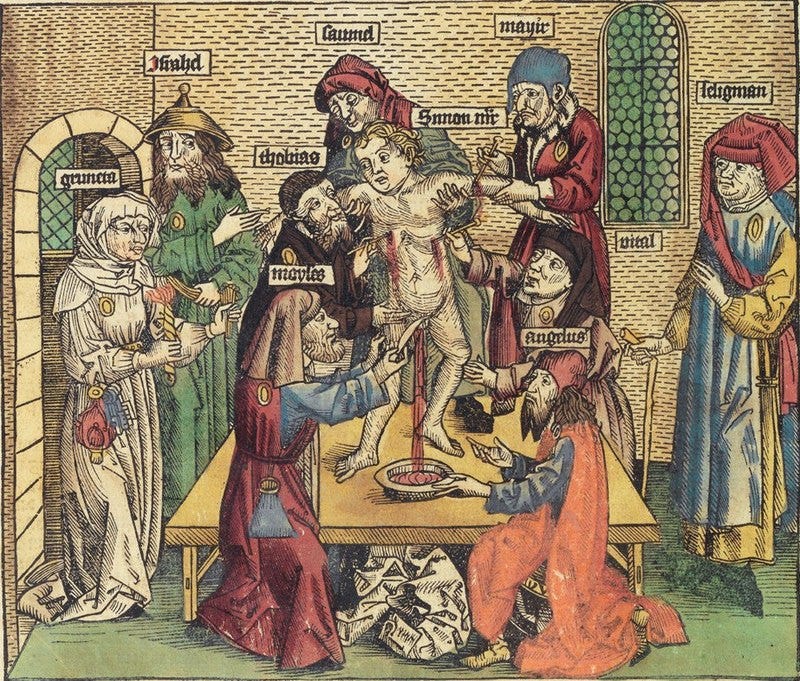From Human Animals to Bloodthirsty Monsters
The rhetoric of dehumanization in Israel's war against Hamas
In my last essay, I explained that when Israeli defense minister Yoav Gallant said “We are fighting human animals, and we are acting accordingly” it was tantamount to characterizing them as monsters. Some readers wrote to me in private, suggesting that I was going too far. The description of Hamas killers as animals, they said, was nothing more than an expression of moral outrage for their heinous acts.
But now, Benjamin Netanyahu has made it explicit. Today, he said that Israeli soldiers “understand the scope of the mission. They are ready to take action at any time in order to defeat the bloodthirsty monsters who have risen against us to destroy us.”
I think that this is extremely ominous. This is not because I am sympathetic to Hamas. I am not. It is not because I am an anti-Semite. I am not. In fact, notwithstanding my very Christian name, I am Jewish, and I would be happy to see Hamas obliterated.
I think that Netanyahu’s choice of words is ominous because, having studied the rhetoric of dehumanization for nearly twenty years, I know all too well what this kind of rhetoric implies.
The worst, the most deadly, form of dehumanization represents the dehumanized other as a monster—an uncanny incarnation of pure evil rather than a human being. But whatever one might say about the hideous atrocities perpetrated by Hamas, it is patently false to claim that these atrocities were not committed by human beings.
The details of the psychological and political causes of the monsterization of others are too complex to explain in an essay like this. Those who are really interested can consult my book Making Monsters: The Uncanny Power of Dehumanization. The point that I want to make here—the point that leads me to regard Netanyahu’s language as so ominous—is that when we dehumanize others as monsters, we essentialize them in a particular way. We think of them as a distinct, racialized kind of being. They—these monstrous others—are deep down all the same. Even if they do not manifest the same properties, they have it in them to do so. Given this pattern of thinking, these racial others, these monsters, must be utterly obliterated—destroyed without quarter.
Characterizing the dehumanized other as “bloodthirsty” adds to the picture. A bloodthirsty entity is a vampire—a being that wants to drink human blood. This is a classic dehumanizing trope, for reasons that I will explain in a future essay. Ironically, it is the basis of the centuries-old “blood libel” that Jews consumed the blood of Christian children.

In the case at hand, then. Netanyahu’s call to dismantle the bloodthirsty monsters of Hamas has implications that go far beyond the destruction of Hamas. If I am right (and I sincerely hope that I am not), it amounts to a call for the utter brutalization not just of Hamas, but of the Palestinian people.





David, you say that you would be happy to see Hamas obliterated, but we know that "Hamas" includes policemen, doctors, nurses, and kindergarten teachers. Hamas is a broad church, just like the Ba'ath Party in Iraq.
Further, I wonder if you really know a great deal about Hamas or whether you are relying upon the Western media's portrayal of them. They are a far more complex organisation than we have been led to believe. Have you, for example, read any of the books by experts in the field who have actually met and interviewed members of Hamas such as Dr Paola Caridi, Dr Khaled Hroub or Dr Jeroen Gunning?
With respect to the events of October 7th I suggest that you watch the documentary "October 7" produced by Al Jazeera Investigations if you have not yet done so.
I’ve been reading your book Making Monsters. I’m happy to see someone taking on this subject in the way you do. I’d been wondering though if you had omitted Palestinians from your research? Maybe you’ll get to it later in the book but in general I’d be interested in reading more if you’ve written anything else about their situation? This is my first encounter with your substack so forgive me if you covered it more extensively here. I’ll poke around